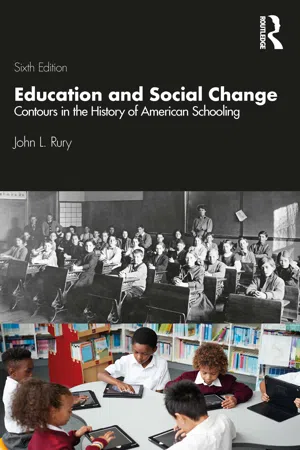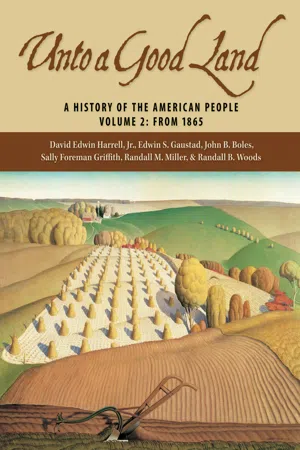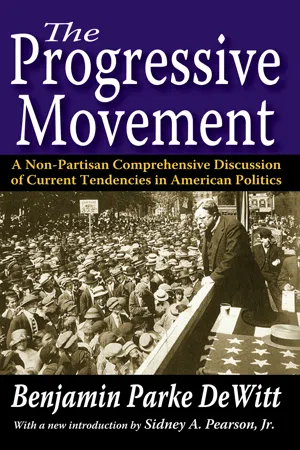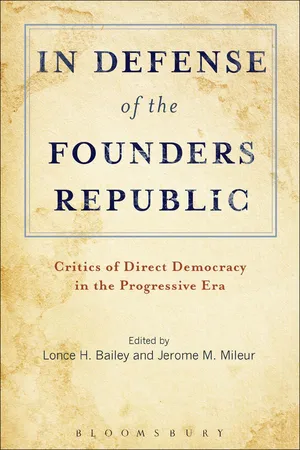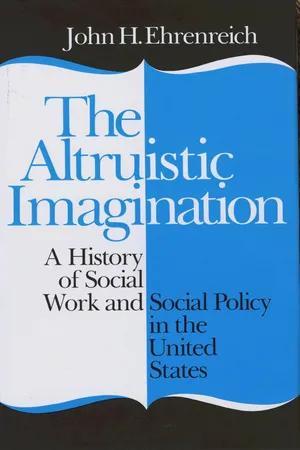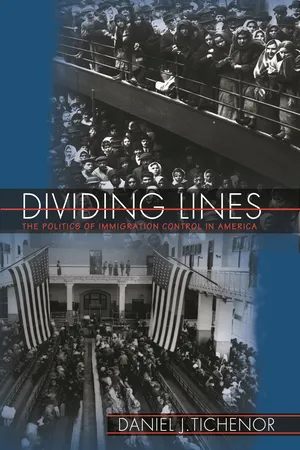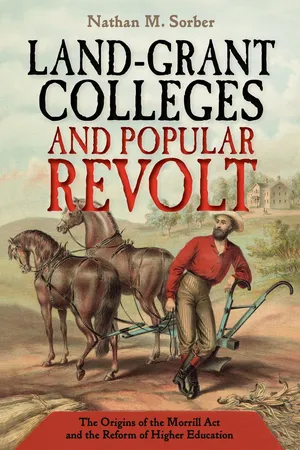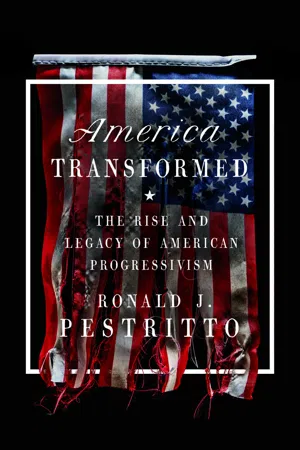History
Origins of Progressivism
The origins of progressivism in the late 19th and early 20th centuries stemmed from a desire to address social and political issues resulting from industrialization and urbanization. Progressives sought to reform government, improve working conditions, and address social inequalities through various means such as regulation, labor laws, and social welfare programs. This movement was characterized by a belief in the ability of government to enact positive change.
Written by Perlego with AI-assistance
Related key terms
10 Key excerpts on "Origins of Progressivism"
- eBook - ePub
Reconsidering American Liberalism
The Troubled Odyssey Of The Liberal Idea
- James Young(Author)
- 2018(Publication Date)
- Routledge(Publisher)
10 The Problem of ProgressivismTHE ORIGINS of the modern American state lie in the ideas and institutional changes of the Progressives. The state that the Progressive movement fostered, which began an attempt to make peace with modernity, produced results that can hardly have been what the populists had in mind. Nevertheless, the incipient modern state did introduce into American politics a conception of activist government, which the populists had previously championed, and it also adopted some of their institutional remedies. As with populism, the historiography of progressivism is extremely complex, so much so that some historians have proposed discarding the very term as conceptually useless.1 This solution has not taken hold, so it is necessary to try to sort out at least some of the conflicting viewpoints. Part of the difficulty no doubt lies in the fact that progressivism, unlike populism, was a national movement, which manifested itself at the federal, state, and local levels of government and which was subject to considerable ideological debate and political infighting. Moreover, there was often a gap between the fierce moral rhetoric of the movement and its actual accomplishments. Therefore, some observers have been moved, perhaps not entirely without reason, to question the motives of the reformers. One might add that the moral rhetoric of the political leaders often contrasted with the relativism of the Progressive philosophers.Progressivism, though heir to a good deal of populist rhetoric and ideology, was primarily an urban, middle-class phenomenon; it lasted for a considerable period of time—conventionally, from 1900 to 1920. However, perhaps more important than who the Progressives were and where they were located was the fact that they, unlike the populists, produced a great deal of social and political theory. Further, to a great extent, those ideas continue to be of great importance in shaping contemporary liberal thought. To some extent, reform liberals today might be said to be living still on the intellectual capital of progressivism. - eBook - ePub
Education and Social Change
Contours in the History of American Schooling
- John L. Rury(Author)
- 2019(Publication Date)
- Routledge(Publisher)
4Growth, Reform, and Differentiation
The Progressive Era
On January 1, 1901, Americans enthusiastically greeted the 20th century, proclaiming it a time of boundless possibility. Although many prophecies proved far-fetched, the general sentiment was contagious. From the standpoint of social change, the opening decades of the new era were among the most momentous in history. It was a time of tremendous economic development and widespread reform. A modern urban civilization burst into view, raising a host of new social questions. Many of today’s public institutions and policies took shape then, including the school system.The period between 1890 and 1920 is often called the Progressive Era. The phrase conveys a sense of improvement or progress that many felt, especially regarding social reform. It reflected the influence of such leaders as Teddy Roosevelt and Woodrow Wilson, and the muckraking journalism of Ida Tarbell, Jacob Riis, and Lincoln Steffens, among others. Schools were an important aspect of this; it was a time of many new educational ideas and practices. In fact, a major current of pedagogical thought has been labeled “progressive education” ever since. This has been a recurring source of controversy and debate, but continues to inspire many educators today. Consequently, understanding progressivism in education is an important reason to examine this period (Goldman, 1952; Hofstadter, 1955b; May, 1964).Education and social reform, however, did not dictate the basic tenor of the age. Rather, forces of industrialization and urban growth defined it, factors that had spurred change in earlier times. The difference was magnitude and pace. By the 20th century, the degree of industrial development and urbanization had reached levels scarcely imaginable decades earlier. Corporate enterprises reached a mammoth scale, serving far-flung markets with new technologies designed for mass production. Industrial expansion accelerated, boosting international trade and migration. The country was losing its pastoral character in the wake of incipient globalization (O’Rourke & Williamson, 2001). Cities swelled as millions of immigrants arrived to seek jobs. Cultural diversity became even more pronounced and dozens of languages could be heard on the streets. American society seemed to be rapidly changing in ways difficult to fathom (Hays, 1957/1995; Higgs, 1971; Rodgers, 1998). This became a source of new anxieties, and eventually a focal point for reform. As noted by historian Robert Wiebe, a “search for order” became emblematic of a new stage in American history (Wiebe, 1967). - eBook - ePub
Unto a Good Land
A History of the American People, Volume 2: From 1865
- David Edwin Harrell, Edwin S. Gaustad, John B. Boles, Sally Foreman Griffith(Authors)
- 2005(Publication Date)
- Eerdmans(Publisher)
24
Progressivism in American Politics, 1901 to World War I
Chapter 24 at a Glance The Core of the Progressive Agenda The Urban Social Justice Movement Saving the WASP Empire Local and State Political Reform Reorganizing American Cities Progressivism in the States Electoral Reform—Democratic and Undemocratic States Provide Models for Progressive Legislation Theodore Roosevelt and the Selling of National Progressivism Theodore Roosevelt Takes Center Stage The Extension of Regulation and Trustbusting Political Victory and the Square Deal A Beginning for Conservation Roosevelt Drifts to the Left Competing Progressive Visions Roosevelt Picks His Successor Taft Alienates the Progressives The Rift between Roosevelt and Taft The Election of 1912 Wilsonian Progressivism The Scholar President Congress Backs the President Expanding the New Freedom Conclusion: The Legacy of Political ProgressivismT HE ANXIETIES CAUSED by rapid social and economic change at the turn of the century defined the Progressive Era as a time of causes and crusades. The reform sentiment of the period took on added significance because most progressives looked to government to restore the American dream, and they relished political combat. The governmental reforms of the Gilded Age, including civil service reform and the growing professionalization of the Washington bureaucracy, had set the stage for the progressive movement, and the election of 1896 had provided an agenda for the progressive presidents of the early twentieth century—Theodore Roosevelt, William Howard Taft, and Woodrow Wilson. Progressives backed a broad array of social, economic, and political reforms; no one person was likely to embrace all of them. The federal government enacted the era’s most far-reaching legislation, but progressives won their first political successes at the local and state levels.Nationally, the Progressive Era witnessed a renaissance of presidential leadership, conspicuously lacking in the Gilded Age. Roosevelt and Wilson are generally ranked among the nation’s greatest chief executives, and Taft was a competent (if politically clumsy) and somewhat underrated president. Surrounding these presidents were a colorful and vigorous cast of political characters whose thought and actions helped shape modern America. - eBook - ePub
The Progressive Movement
A Non-Partisan Comprehensive Discussion of Current Tendencies in American Politics
- Benjamin Parke DeWitt(Author)
- 2017(Publication Date)
- Routledge(Publisher)
PART I THE ORIGIN AND DEVELOPMENT OF THE PROGRESSIVE MOVEMENTPassage contains an image
CHAPTER IThe Meaning and History of the Progressive MovementTHE term “progressive movement” has been so widely used, so much discussed, and so differently interpreted that any exposition of its meaning and principles, to be adequate, must be prefaced by careful definition. To some—comparatively few—the progressive movement stands for the attempt of one man, disappointed in his efforts to control his political party, to found another and return himself to power. To others, who are willing to concede that the movement is not confined to a single leader, it represents the efforts of a small body of self-seeking politicians to gain position and influence by making capital of a movement that is temporarily popular. To others, the movement expresses the effort of a few sincere but misguided enthusiasts to carry out an impossible and chimerical program of social reform through government and legislation. Some believe that the movement is partisan, limited to the party that bears its name; others believe that it is broader than any single party and that its supporters are found in political parties everywhere. Some believe it is new, fleeting, and evanescent, destined to disappear quickly from our political life; others hold that it is permanent, deep-seated, and fundamental, involving a modification and readjustment of our political theories and institutions.Whatever difference of opinion may exist concerning the meaning of the progressive movement, every thinking man and woman must be convinced that the nation to-day is passing through a severe political crisis. After a period of unprecedented industrial and commercial expansion, during which time little or no attention has been given to the problems of government, the people have suddenly realized that government is not functioning properly and that radical changes are needed. Manifestations of this excitement and unrest are seen on every hand. Men write of a new democracy1 and a new freedom.2 - Katherine A.S. Sibley(Author)
- 2014(Publication Date)
- Wiley-Blackwell(Publisher)
Richard McCormick in several works, but especially in his book From Realignment to Reform: Political Change in New York State 1893–1910 (1981), argued that progressivism was characterized by the rise of interest groups and the decline of political parties, a model that works well with the changes in social welfare politics. Beginning in the early 1990s, Theda Skocpol, a political scientist and sociologist, brought a social science-infused approach to the New Left historical concerns as she began to track the evolution of American social welfare from the 1800s to the present (see below). And from a third direction, Steven Diner’s A Very Different Age: Americans of the Progressive Era, sought to synthesize the period by focusing on how Americans sought to control their lives and the government through the upheavals at the end of nineteenth century, an echo of the older Hofstadter concern, but one fleshed out by the latest research in social history and using industrialism, corporate capitalism, progressive reform and the emergence of large-scale organizations as his “backdrop” (Diner 1998: 8). Skocpol has also led a movement to examine the means by which these organizations exerted political power and sought change in civil reform and social welfare matters. Riffing off Tocqueville’s observation that Americans had a propensity to form associations for all manner of activities, from social, to political, to religious, rather than producing a “government or administration” (1997: 457), Skocpol concludes that the antebellum period and the subsequent Progressive Era proliferation of voluntary associations was not simply a “by-product of commercialization and urbanization” (1997: 466–467). Instead, this trend was heavily influenced by the provision of national travel and communications networks supported by the central government- eBook - ePub
In Defense of the Founders Republic
Critics of Direct Democracy in the Progressive Era
- Lonce H. Bailey, Jerome M. Mileur(Authors)
- 2015(Publication Date)
- Bloomsbury Academic(Publisher)
1 Introduction: Progressivism and its Critics Lonce H. Bailey Shippensburg UniversityThere has been a revival of scholarly interest in the Progressive Era over the past several decades. The role of Progressive reforms in the development of the American national state has been widely explored, as have questions about their philosophical or ideological coherence as they have played out in the twentieth century’s two subsequent periods of liberal reform. There is general agreement about the governmental legacy of Progressivism: a much enlarged and more bureaucratic, managerial, and technocratic national state with a more robust presidency at its center, a larger role for public opinion in day-to-day governance, a diminished role for representative institutions in politics and government, and more opportunities for direct citizen intervention in government at the state and local levels. There is general agreement as well about its political legacy: political parties were weakened in elections and governance, direct primaries and candidate-centered campaigns gained prominence, democracy and political process became more important in political debates and constitutionalism less so, women gained the vote, groups became more prominent, and private money more important. Progressivism, and the liberalism that followed it, has had its critics on both the Left and Right, political as well as academic, but other than “big government,” these criticisms have centered, to a remarkable degree, on public policy rather than institutional issues. Basic constitutional questions were raised to which responses from reformers were more often assumed or asserted than explored or analyzed. What does popular government mean? What is the role of citizens and of public opinion in a democracy? What is the role of representation and of executive leadership in a democratic system? What is the role of mediating institutions in legislative bodies and elections? What is the effect of reform on constitutional - eBook - ePub
The Altruistic Imagination
A History of Social Work and Social Policy in the United States
- John Ehrenreich(Author)
- 2014(Publication Date)
- Cornell University Press(Publisher)
1
The Origins of American Social Policy
Modern American social policy and the social work profession as we know it today were born in the Progressive Era, the two decades or so immediately preceding World War I.1 To understand social policy and social work by examining them in their contemporary, “mature” form would require a difficult task of excavation. We would have to unravel their “true” natures from their self-descriptions and aspirations, to get under their surfaces to identify the functions they serve, the social forces they represent, the logic of their structure. To go back in time, however, to a period when the very idea of “social policy,” the very concept of “social work” had not yet been developed, when no names had yet been applied to link disparate ideas, occupations, and social purposes, is to simplify our task radically. For in the formative period, the fears and hopes that created social policy and engendered social work were openly stated, clearly revealed.At a distance of almost a century, we tend to romanticize the turn-of-the-century years. They were the “gay nineties,” the years of “Daisy, Daisy, give me your answer, do,” of Teddy Roosevelt charging up San Juan Hill to the cheers of small-town America, of children shouting “Get a horse” to the first intrepid motorists. But, in fact, the decades from 1877 to World War I were a time of deep economic, social, and political crisis in American society. Social work and social policy first emerged as a more-or-less conscious effort to deal with that crisis, to stabilize American industrial society. To understand that effort, we must first examine the turn-of-the-century crisis in some detail.The half century following the Civil War was the great period of industrialization in the United States. From a predominantly agricultural, rural land, of no great importance in the world, the United States became the world’s leading industrial power. A few statistics tell the story well enough for our purposes: the 37,000 miles of railroad track of 1865 multiplied sevenfold, to 253,000 miles, 39 percent of the entire world’s total, by 1914. Energy production—a good measure of both industrialization and urbanization—soared: coal from 15 million tons in 1860 to 514 million tons in 1914, oil from 74 million barrels over the period 1857–75 to 266 million barrels in 1914 alone. In 1859, just before the Civil War, slightly more than 1 million industrial workers produced industrial goods worth about $2 billion and more than 60 percent of the U.S. labor force was still engaged in agriculture. By 1914 seven times as many workers labored in industry, producing twelve times as many goods as half a century earlier, and the proportions of agricultural and nonagricultural workers were reversed: 69 percent of the work force had non agricultural jobs.2 - eBook - ePub
Princeton Studies in American Politics
The Politics of Immigration Control in America
- Daniel J. Tichenor(Author)
- 2009(Publication Date)
- Princeton University Press(Publisher)
CHAPTER FIVE Progressivism, War, and Scientific Policymaking THE RISE OF THE NATIONAL ORIGINS QUOTA SYSTEM, 1900–1928IMMIGRATION restrictionists of the early-twentieth century, like most other Progressive Era reformers, believed that bold new forms of national governance were necessary to restore economic, social, and political order to a country enduring wrenching change. Many viewed the late-nineteenth century as a time of disquieting turbulence. The closing of the frontier and the expansion of an urban industrial economy fostered greater economic interdependence that threatened cherished local autonomy. The period saw the rise of new forms of poverty that strained local relief efforts, as well as labor upheaval and socialist movements—sedate versions of class conflict and radicalism that Americans thought would never surface on this side of the Atlantic.1 As one scholar wrote at the time, “the fate of our country has been in what Edmund Burke describes as ‘a perilous and and dancing balance.’ Every day is a day of crisis.”2 The decentralized, self-regulating society that prevailed for much of American history was, in the view of Progressive Era restrictionists, a luxury of the past. To the civic reformer and IRL vice president Joseph Lee, immigration was the sort of dangerous force that the federal government most desperately needed to tame through rational legislation and administration. “In political life, liberty meant until recently the minimum of control necessary to secure equal opportunity,” he noted. “We have begun to realize the control of man over nature, and to see that the highest results come from the collective effort consciously directed to an end. These considerations have a direct bearing upon the question of immigration regulation.”3 - eBook - ePub
Land-Grant Colleges and Popular Revolt
The Origins of the Morrill Act and the Reform of Higher Education
- Nathan M. Sorber(Author)
- 2018(Publication Date)
- Cornell University Press(Publisher)
CHAPTER 5Progressivism and the Rise of Extension
The resounding defeat of the People’s Party in the 1896 presidential election signaled the end of populism as a national political movement. The 1890s were also the high-water mark for grange political activism, for in the coming century, the organization would increasingly focus on social services for farmers and the promotion of rural uplift. However, several planks of the populist and granger agenda found expression in a largely urban-based, middle-class movement known as progressivism. Akin to their rural forerunners, progressives wrestled with the ill effects of industrialization and sought redress through political action. Muckrakers like Lincoln Steffens in The Shame of the Cities (1904) and Upton Sinclair in The Jungle (1906) exposed corruption in American politics and the ruthless, unsafe, and collusive practices of American industry. It was a movement that cut across political lines, as both Republican Theodore Roosevelt and Democrat Woodrow Wilson identified themselves as progressives. Instead of preaching revolutionary action to dismantle capitalism like the communists, progressives aimed to “ameliorate the … worst conditions of industrial life.”1 Private utility companies came under public control, big businesses faced antitrust scrutiny, and railroads operated under strict regulation. The period witnessed restrictions on child labor, the introduction of workers’ compensation schemes, limits on working hours, and the instigation of factory safety and sanitation controls. Political reforms included initiatives previously promoted by populists—the direct election of senators and the federal income tax—as well as new departures such as the direct primary, the state ballot initiative, recalls, and referenda. Progressives achieved constitutional changes to address women’s political rights and alcohol prohibition with the passage of the eighteenth and nineteenth amendments.2 - eBook - ePub
America Transformed
The Rise and Legacy of American Progressivism
- Ronald J. Pestritto(Author)
- 2021(Publication Date)
- Encounter Books(Publisher)
Strong attachment to religious faith is associated far more strongly with the Right than with the Left in America, and thus it is often assumed that liberal political ideology—progressivism, in this case—grew out of, or was accompanied by, some kind of atheism or anti-religious animus. In the case of America’s original progressives, however, this was far from the case. While there were certainly some progressive figures who were overtly hostile to revealed religion 2 (one thinks, for instance, of The New Republic founder and editor Herbert Croly, whose parents literally baptized him into the atheistic “church of humanity” devoted to the positivism of Auguste Comte), as a whole the movement was profoundly bound up with religious belief and many in it were driven by a sincere and fervent Christianity. This chapter endeavors to address the connection between progressive political principles and the Social Gospel movement that was common among America’s original adherents to progressivism. THE RISE OF SOCIAL GOSPEL To read the speeches of many of the most prominent progressives, pronouncing on the most important issues of that era, is to read the kind of religious language and fervor that would only be associated with the so-called “religious Right” of our own time. Recall these excerpts from two of the most renowned speeches of the Progressive Era: Our cause is based on the eternal principle of righteousness; and even though we who now lead may for the time fail, in the end the cause itself shall triumph…
Index pages curate the most relevant extracts from our library of academic textbooks. They’ve been created using an in-house natural language model (NLM), each adding context and meaning to key research topics.

